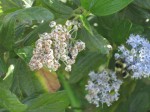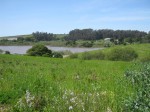Farm Practices
 As a certified organic farm, we get a lot of questions about how we grow our vegetables, what materials we use on our crops, and so on. While most non-farmers know very little about farming, a lot of people know a lot about gardening, and many people have done research about those aspects of farming that might affect their health or the environment. These issues include use of genetically modified seeds (GMOs), pesticides, herbicides, and fertilizers; energy use; water use; and water run-off.
As a certified organic farm, we get a lot of questions about how we grow our vegetables, what materials we use on our crops, and so on. While most non-farmers know very little about farming, a lot of people know a lot about gardening, and many people have done research about those aspects of farming that might affect their health or the environment. These issues include use of genetically modified seeds (GMOs), pesticides, herbicides, and fertilizers; energy use; water use; and water run-off.
Any farm that is certified organic is required to adhere to a number of rules relating to these issues. While in some cases they don’t go far enough, for the most part the requirements of certification are a guarantee that the farm is growing vegetables in a sustainable and environmentally friendly manner. GMO seeds are not allowed in organic farming under any circumstance. Certified organic farmers are allowed to use non-organic seeds only if organic seed is not readily available for that variety; the seeds must be untreated (e.g. not predipped in fungicide). We use organic seed whenever possible, and we grow our own starts in our greenhouse so we have control over everything that goes into nurturing the young plants. We use organic cover crop seeds. We use organic seed potatoes. When available we use organic crowns to start our strawberry plants. This year we held over two acres of strawberries from last year that had started from organic crowns. (Organic crowns were not available at fall planting time for this year’s crop. See Steve’s article on this from 2010.) To us, using organic seeds is an obvious part of farming organically. The more farmers buy organic seeds the more organic seed the seed growers will produce.
While  there are some organic-approved pesticides, such as Neem or Safer soap, we do not use any of these on our crops. We have a variety of ways to handle pest issues. As a diverse farm growing small blocks of many different vegetables, we are not subject to the same level of pest pressure that can develop on a many-acre crop of a single vegetable. A crop-specific pest can easily get out of hand with such a huge source of food in one place. Still we do have pressures from pests. The worst are probably the aphids that love our brassicas (broccoli, cabbage, cauliflower, collards, etc.). Rotating these crops to different areas of our farm, and tilling them in as soon as they are finished help to keep the aphid levels in check. We also provide substantial habitat (we have native plant hedgerows along most of our farm borders now) for beneficial insects on our farm who like to eat aphids and other crop pests. In addition, we plant alyssum in rows between our brassicas and lettuces to attract beneficial syrphid flies—the larval form of the syrphid fly eats aphids. And we have a thriving population of ladybugs. In the case of strawberries, we actually release a beneficial predatory mite to eat the tiny but terrible two-spotted mite that can be a huge problem for strawberries.
there are some organic-approved pesticides, such as Neem or Safer soap, we do not use any of these on our crops. We have a variety of ways to handle pest issues. As a diverse farm growing small blocks of many different vegetables, we are not subject to the same level of pest pressure that can develop on a many-acre crop of a single vegetable. A crop-specific pest can easily get out of hand with such a huge source of food in one place. Still we do have pressures from pests. The worst are probably the aphids that love our brassicas (broccoli, cabbage, cauliflower, collards, etc.). Rotating these crops to different areas of our farm, and tilling them in as soon as they are finished help to keep the aphid levels in check. We also provide substantial habitat (we have native plant hedgerows along most of our farm borders now) for beneficial insects on our farm who like to eat aphids and other crop pests. In addition, we plant alyssum in rows between our brassicas and lettuces to attract beneficial syrphid flies—the larval form of the syrphid fly eats aphids. And we have a thriving population of ladybugs. In the case of strawberries, we actually release a beneficial predatory mite to eat the tiny but terrible two-spotted mite that can be a huge problem for strawberries.
To improve the soil fertility our main approach is extensive use of cover crops and compost. When a crop needs a very high fertility (like strawberries) we use organic fertilizers made from feather meal, chicken manure, and fish emulsion. (Some day I’ll tell the story of when Steve was fertilizing through the irrigation pipes and his backflow valve wasn’t working properly—let’s just say that it takes a long time to feel clean again after showering in fish emulsion.) The fertilizers we use are always certified for use in organic farms (and home showers).
Another environmental consideration in farming is the high energy use associated with tractors and transportation. Compared to the average distance travelled by vegetables consumed in the United States of about 1500 miles, we figure we’re doing pretty good with our local delivery. In regard to tractor use, we use a lot less primary tillage in preparing our fields, partly because the cover crops improve the tilth of the soil so that it doesn’t need as many passes with the tractor. Over the past 5 years, Steve has been making use of a conservation tillage disc to “recycle” beds during the year, so that he only lists up a bed once a year and uses it for successive crops without having to rework the bed. Farmers raise up rows of soil into beds to provide good drainage and ease of cultivation and harvesting. We may get three or four successive quick growing crops from a single bed during the course of the season. In order to save tractor passes and preserve the microbial life in the soil, the conservation tillage disc incorporates crop residue and reworks the same bed up. This results in maybe half the tractor passes as would be used on a standard farm.
 We conserve water wherever possible by irrigating only when necessary and using drip tape on crops that will be in the ground for a large part of the season. All our orchards, blueberries, strawberries, and squashes are on drip tape. In 2009 we were awarded the AWQA (Agriculture Water Quality Alliance) Stewardship Award for our practices preventing water run-off, including a buffer strip of willows planted in an existing drainage swale on our farm.
We conserve water wherever possible by irrigating only when necessary and using drip tape on crops that will be in the ground for a large part of the season. All our orchards, blueberries, strawberries, and squashes are on drip tape. In 2009 we were awarded the AWQA (Agriculture Water Quality Alliance) Stewardship Award for our practices preventing water run-off, including a buffer strip of willows planted in an existing drainage swale on our farm.
We are always looking for ways to improve our farming practices, keep our soil healthy, and maintain a thriving native environment around our farm. We encourage you to come out and see us this Saturday at our new Lewis Rd. property in Monterey county for a walking tour. Steve will talk about the year that he spent preparing this land to farm and his hopes and dreams for this beautiful little slice of ground.
Search High Ground Site
High Ground Favorites Cloud
apples arugula basil beets braise broccoli carrots cauliflower celery chard cheese cilantro dressing fennel fish herbs kale leeks lemon lettuce Meyer lemon mint mushrooms nuts onions oregano parsley peppers pork potatoes quickles radishes salad sauce saute scallions soup strawberries summer squash tomatoes topping vegan vegetarian vinaigrette winter squash


